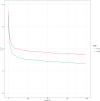Detection of selection signatures in farmed coho salmon (Oncorhynchus kisutch) using dense genome-wide information
- PMID: 33958603
- PMCID: PMC8102513
- DOI: 10.1038/s41598-021-86154-w
Detection of selection signatures in farmed coho salmon (Oncorhynchus kisutch) using dense genome-wide information
Abstract
Animal domestication and artificial selection give rise to gradual changes at the genomic level in populations. Subsequent footprints of selection, known as selection signatures or selective sweeps, have been traced in the genomes of many animal livestock species by exploiting variation in linkage disequilibrium patterns and/or reduction of genetic diversity. Domestication of most aquatic species is recent in comparison with land animals, and salmonids are one of the most important fish species in aquaculture. Coho salmon (Oncorhynchus kisutch), cultivated primarily in Chile, has been subjected to breeding programs to improve growth, disease resistance traits, and flesh color. This study aimed to identify selection signatures that may be involved in adaptation to culture conditions and traits of productive interest. To do so, individuals of two domestic populations cultured in Chile were genotyped with 200 thousand SNPs, and analyses were conducted using iHS, XP-EHH and CLR. Several signatures of selection on different chromosomal regions were detected across both populations. Some of the identified regions under selection contained genes such anapc2, alad, chp2 and myn, which have been previously associated with body weight in Atlantic salmon, or sec24d and robo1, which have been associated with resistance to Piscirickettsia salmonis in coho salmon. Findings in our study can contribute to an integrated genome-wide map of selection signatures, to help identify the genetic mechanisms of phenotypic diversity in coho salmon.
Conflict of interest statement
The authors declare no competing interests.
Figures







Similar articles
-
Genomic Predictions and Genome-Wide Association Study of Resistance Against Piscirickettsia salmonis in Coho Salmon (Oncorhynchus kisutch) Using ddRAD Sequencing.G3 (Bethesda). 2018 Mar 28;8(4):1183-1194. doi: 10.1534/g3.118.200053. G3 (Bethesda). 2018. PMID: 29440129 Free PMC article.
-
Genome-wide association analysis reveals loci associated with resistance against Piscirickettsia salmonis in two Atlantic salmon (Salmo salar L.) chromosomes.BMC Genomics. 2015 Oct 24;16:854. doi: 10.1186/s12864-015-2038-7. BMC Genomics. 2015. PMID: 26499328 Free PMC article.
-
Multi-tissue transcriptome profiles for coho salmon (Oncorhynchus kisutch), a species undergoing rediploidization following whole-genome duplication.Mar Genomics. 2016 Feb;25:33-37. doi: 10.1016/j.margen.2015.11.008. Epub 2015 Nov 21. Mar Genomics. 2016. PMID: 26614614
-
Continuous light (relative to a 12:12 photoperiod) has no effect on anxiety-like behaviour, boldness, and locomotion in coho salmon (Oncorhynchus kisutch) post-smolts in recirculating aquaculture systems at a salinity of either 2.5 or 10 ppt.Comp Biochem Physiol A Mol Integr Physiol. 2022 Jan;263:111070. doi: 10.1016/j.cbpa.2021.111070. Epub 2021 Sep 10. Comp Biochem Physiol A Mol Integr Physiol. 2022. PMID: 34509593 Review.
-
Immunization with bacterial antigens: piscirickettsiosis.Dev Biol Stand. 1997;90:161-6. Dev Biol Stand. 1997. PMID: 9270845 Review.
Cited by
-
Assessing Genomic Diversity and Signatures of Selection in Chinese Red Steppe Cattle Using High-Density SNP Array.Animals (Basel). 2023 May 22;13(10):1717. doi: 10.3390/ani13101717. Animals (Basel). 2023. PMID: 37238146 Free PMC article.
-
Genetic Diversity and Signatures of Selection in the Roughskin Sculpin (Trachidermus fasciatus) Revealed by Whole Genome Sequencing.Biology (Basel). 2023 Nov 13;12(11):1427. doi: 10.3390/biology12111427. Biology (Basel). 2023. PMID: 37998026 Free PMC article.
-
Genome-wide detection of positive and balancing signatures of selection shared by four domesticated rainbow trout populations (Oncorhynchus mykiss).Genet Sel Evol. 2024 Feb 22;56(1):13. doi: 10.1186/s12711-024-00884-9. Genet Sel Evol. 2024. PMID: 38389056 Free PMC article.
-
Environment and genotype predict the genomic nature of domestication of salmonids as revealed by gene expression.Proc Biol Sci. 2022 Dec 14;289(1988):20222124. doi: 10.1098/rspb.2022.2124. Epub 2022 Dec 7. Proc Biol Sci. 2022. PMID: 36475438 Free PMC article. Review.
-
Analysis of genetic diversity and population structure among cultivated potato clones from Korea and global breeding programs.Sci Rep. 2022 Jun 21;12(1):10462. doi: 10.1038/s41598-022-12874-2. Sci Rep. 2022. PMID: 35729234 Free PMC article.
References
-
- Bertolini F, Servin B, Talenti A, Rochat E, Kim ES, Oget C, Palhière I, Crisà A, Catillo G, Steri R, Amills M, Colli L, Marras G, Milanesi M, Nicolazzi E, Rosen BD, Van Tassell CP, Guldbrandtsen B, Sonstegard TS, Tosser-Klopp G, Stella A, Rothschild MF, Joost S, Crepaldi P, Adaptmap C. Signatures of selection and environmental adaptation across the goat genome post-domestication. Genet. Sel. Evol. GSE. 2018;50:57–57. doi: 10.1186/s12711-018-0421-y. - DOI - PMC - PubMed
-
- Qanbari S, Simianer H. Mapping signatures of positive selection in the genome of livestock. Livest. Sci. 2014;166:133–143. doi: 10.1016/j.livsci.2014.05.003. - DOI
-
- Grossman S, Shylakhter I, Karlsson E, Byrne E, Morales S, Frieden G, Hostetter E, Angelino E, Garber M, Zuk O, Lander E, Schaffner S, Sabeti P. A composite of multiple signals distinguishes causal variants in regions of positive selection. Science. 2010;327:883–886. doi: 10.1126/science.1183863. - DOI - PubMed
Publication types
MeSH terms
Supplementary concepts
LinkOut - more resources
Full Text Sources
Other Literature Sources
Research Materials

